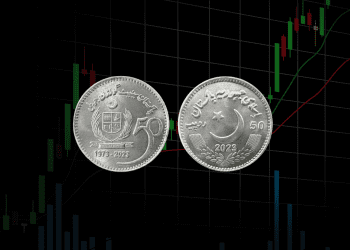The relationship between gold, oil, and the U.S. Dollar Index (DXY) is intricate, driven by various economic forces such as inflation and interest rates. These assets often interact in predictable ways, with the strength of the U.S. dollar exerting significant influence over the prices of gold (XAU/USD) and oil (XTI/USD). As global economic conditions shift, understanding these dynamics becomes crucial for investors and market analysts alike. This article explores how inflation, interest rates, and the U.S. Dollar Index affect gold and oil prices, shaping their long-term trends.
1. GOLD (XAU/USD) & DOLLAR INDEX (DXY):
Inverse Relationship: Typically, gold and the dollar index have an inverse relationship. When the DXY (which measures the U.S. dollar’s strength against a basket of major currencies) rises, the price of gold tends to fall, and vice versa. This is because gold is priced in dollars; a stronger dollar makes gold more expensive for holders of other currencies, reducing demand.
Safe-Haven Asset: Gold is often seen as a hedge against currency devaluation and inflation. In times of economic uncertainty, investors buy gold as a safe store of value, even if the dollar weakens.
2. OIL (XTI/USD) & DOLLAR INDEX (DXY):
Inverse Relationship: Oil, like gold, is priced in dollars, and thus a stronger dollar typically leads to lower oil prices. A rising DXY makes oil more expensive in other currencies, potentially reducing global demand.
Economic Growth Indicator: Oil is also closely tied to global economic growth. A stronger U.S. dollar can weigh on oil prices by reducing demand, particularly in emerging markets where currencies weaken relative to the dollar.
3. GOLD & OIL (XAU/USD & XTI/USD):
Inflation and Commodities: Both gold and oil are considered commodities, and they often move in response to inflation expectations. Rising oil prices can lead to higher inflation, which may boost demand for gold as an inflation hedge.
Cost of Production: Oil prices can influence the cost of gold production. Higher oil prices can increase mining and transportation costs, which may indirectly support higher gold prices.
SUMMARY:
DXY vs. XAU/USD and XTI/USD: Generally, a stronger dollar (higher DXY) leads to lower gold and oil prices, while a weaker dollar can push both commodities higher.
XAU/USD and XTI/USD: While not directly correlated, both can rise in inflationary environments or fall when the dollar strengthens.
These relationships aren’t perfect and can be influenced by many factors, including geopolitical events, interest rates, and global demand.
INTEREST RATES
When we introduce interest rates into the equation with gold (XAU/USD), oil (XTI/USD), and the U.S. Dollar Index (DXY), the relationship becomes more complex due to the direct impact of interest rates on currencies, commodities, and investor behavior.
1. INTEREST RATES & GOLD (XAU/USD):
Inverse Relationship: Higher interest rates typically lead to lower gold prices. This is because gold is a non-yielding asset, meaning it doesn’t generate interest or dividends. When interest rates rise, investors are more inclined to put money into interest-bearing assets like bonds or savings accounts, which offer a return.
Opportunity Cost: Rising interest rates increase the opportunity cost of holding gold. Investors prefer assets that can provide a return, making gold less attractive in a high-rate environment.
Safe Haven: However, in times of financial crisis or high inflation, gold can still rise despite higher interest rates as it serves as a hedge against uncertainty and inflation.
2. INTEREST RATES & OIL (XTI/USD):
Indirect Relationship: The relationship between oil and interest rates is more indirect compared to gold. Higher interest rates can lead to:
Stronger U.S. Dollar: As interest rates rise, the U.S. dollar typically strengthens because higher rates attract foreign investment into U.S. assets. Since oil is priced in dollars, a stronger dollar makes oil more expensive for countries using other currencies, which can reduce global demand and lower oil prices.
Economic Growth Impact: Higher interest rates increase borrowing costs for consumers and businesses, which can slow economic growth. Slower growth usually means lower demand for oil, leading to downward pressure on prices.
Inflationary Pressures: On the other hand, higher oil prices can drive inflation, and central banks may raise rates to combat inflation. This can create a feedback loop where rising interest rates eventually curb demand and lower oil prices.
3. INTEREST RATES & DOLLAR INDEX (DXY):
Direct Relationship: Higher interest rates generally lead to a stronger U.S. dollar (DXY). When the Federal Reserve or any central bank raises interest rates, it makes the currency more attractive to investors because they can earn higher returns from assets in that currency. As more investors buy into dollar-denominated assets, the DXY strengthens.
Capital Flows: Higher rates tend to attract foreign capital into the U.S., boosting demand for the dollar and raising the DXY. A stronger dollar reduces the attractiveness of commodities like gold and oil, which are priced in dollars.
4. OVERALL RELATIONSHIP:
Higher Interest Rates:
Lead to a stronger U.S. dollar (DXY) as foreign capital seeks higher yields in the U.S.
Lower gold prices (XAU/USD) due to the opportunity cost of holding non-yielding assets.
Potentially lower oil prices (XTI/USD) due to a stronger dollar and reduced demand. However, oil prices could remain elevated if there are supply constraints or inflationary pressures.
Lower Interest Rates:
Weaken the U.S. dollar, making gold and oil more attractive to foreign buyers.
Gold prices typically rise as low interest rates reduce the opportunity cost of holding it.
Oil prices can also rise, as lower rates often stimulate economic activity, leading to increased demand for energy.
SUMMARY:
Gold (XAU/USD): Inverse relationship with interest rates. Higher rates → Lower gold prices.
Oil (XTI/USD): Indirect relationship with interest rates. Higher rates → Stronger dollar → Lower oil prices (but inflation or supply factors can influence).
Dollar Index (DXY): Direct relationship with interest rates. Higher rates → Stronger dollar.
These relationships depend on other factors such as inflation, central bank policy, and global economic conditions, making them dynamic and sometimes unpredictable.
When we add inflation into the equation with interest rates, gold (XAU/USD), oil (XTI/USD), and the U.S. Dollar Index (DXY), the dynamics become more layered and interrelated. Inflation directly impacts interest rate decisions, commodity prices, and the value of currencies. Here’s how inflation affects these relationships:
1. INFLATION & INTEREST RATES:
Direct Relationship: Central banks typically raise interest rates in response to high inflation to control rising prices. Higher rates aim to reduce borrowing and spending, cooling down the economy and reducing inflation.
Inflation Targeting: Conversely, when inflation is low or below target, central banks may lower interest rates to stimulate economic activity, encouraging borrowing and spending to push inflation closer to their target.
Expectations: Inflation expectations also drive interest rate decisions. If inflation is expected to rise, central banks may preemptively raise rates, impacting the dollar, gold, and oil prices.
2. INFLATION & GOLD (XAU/USD):
Positive Relationship: Gold is often viewed as a hedge against inflation. When inflation rises, the purchasing power of currencies declines, making tangible assets like gold more attractive. Investors buy gold to protect against the erosion of currency value, driving up gold prices.
Inflation Hedge: Even when interest rates rise in response to inflation, gold may still perform well if inflation remains high or if investors expect further price increases. The perception of gold as a store of value during inflationary periods sustains demand.
Real Interest Rates: The key here is the concept of real interest rates, which are nominal interest rates minus inflation. Even if nominal rates rise, if inflation is high, real rates can remain low or negative, which supports higher gold prices.
3. INFLATION & OIL (XTI/USD):
Positive Relationship: Oil prices and inflation tend to rise together. Oil is a key input in the production and transportation of goods, so higher oil prices lead to higher costs for businesses, which often pass these costs on to consumers, contributing to inflation.
Cost-Push Inflation: Rising oil prices can lead to **cost-push inflation**, where the increasing cost of production causes a rise in overall prices in the economy. This dynamic can lead central banks to raise interest rates to control inflation.
Demand-Side: Inflation driven by strong demand for oil can signal economic growth, pushing oil prices higher. However, rising rates to combat inflation can eventually dampen demand, especially if economic growth slows.
4. INFLATION & DOLLAR INDEX (DXY):
Mixed Relationship: Inflation’s impact on the U.S. Dollar Index (DXY) is more complex. If inflation rises in the U.S. faster than in other countries, it can weaken the dollar as purchasing power erodes, and foreign investors may avoid dollar-denominated assets.
Central Bank Action: However, if the Federal Reserve responds to rising inflation with aggressive rate hikes, the DXY can strengthen because higher rates attract foreign capital seeking better returns. A strong dollar can then reduce inflation by making imports cheaper.
Global Context: The strength of the dollar in an inflationary environment depends on how U.S. inflation compares to inflation in other economies. If inflation is global, the dollar might retain its value or even strengthen, especially if the U.S. raises rates faster than other countries.
5. INFLATION, INTEREST RATES & GOLD:
Inflationary Periods: During high inflation, central banks may raise rates, but if inflation remains elevated, gold can still rise because real interest rates (adjusted for inflation) may be low or negative.
Deflationary Periods: In contrast, when inflation is low or deflationary pressures exist, central banks may lower rates, which often supports gold prices as well, since the opportunity cost of holding gold falls.
6. INFLATION, INTEREST RATES & OIL:
Inflation Driven by Oil: Rising oil prices often lead to higher inflation, prompting central banks to raise interest rates. However, high oil prices can also slow economic growth, eventually leading to lower oil demand and prices.
Stagflation: If inflation remains high while economic growth slows (a scenario called stagflation), oil prices can remain elevated even as central banks raise rates, creating a complex interaction between inflation, rates, and oil.
7. INFLATION, INTEREST RATES & DXY:
Higher Inflation & Dollar Strength: Rising inflation can weaken the dollar, but if the U.S. central bank raises rates more aggressively than other countries, the dollar can strengthen. The stronger dollar can eventually reduce inflation by making imports cheaper but might reduce demand for U.S. exports and commodities priced in dollars.
SUMMARY OF RELATIONSHIPS WITH INFLATION:
1. Gold (XAU/USD):
Positive correlation with inflation** (as gold is seen as a hedge).
Negative correlation with interest rates, but if real interest rates remain low (even with rising nominal rates), gold can still rise.
2. Oil (XTI/USD):
Positive correlation with inflation, as rising oil prices often contribute to inflationary pressures.
Rising oil prices → Higher inflation → Potential rate hikes → Reduced demand for oil in the longer term.
3. Dollar Index (DXY):
Inflation can weaken the dollar if not controlled by higher rates, but aggressive rate hikes in response to inflation can strengthen the dollar by attracting capital inflows.
4. Interest Rates:
Inverse relationship with gold and potential downward pressure on oil, but they rise to combat inflation. Rate hikes lead to a stronger dollar (DXY), lowering gold and oil demand in the global market.
FINAL THOUGHT:
The relationships between inflation, interest rates, gold, oil, and the dollar index are dynamic and multifaceted. While inflation generally supports higher commodity prices (gold and oil), central bank actions (interest rate hikes) in response to inflation can create opposing forces, strengthening the dollar and suppressing commodity demand over time. Understanding how inflation interacts with real rates is crucial for predicting the behavior of these assets.
















